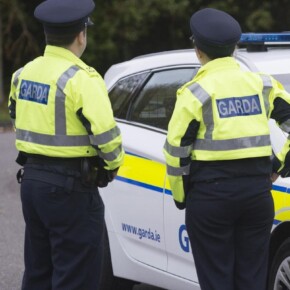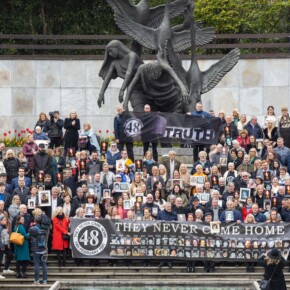Metrolink project is “seriously flawed” says Stewart
Mike Finnerty 04 Apr 2024
There has been one final sting in the tail with the Metrolink hearings.
Prominent environmentalist and television personality Duncan Stewart told the oral hearings that Metrolink should not proceed in its proposed form.
“I personally think the project is seriously flawed,” he said, declaring “this project should be withdrawn at this stage and redesigned.”
He told the hearings that in its current form, the construction of Metrolink is too expensive, would have a limited impact and the emissions produced by the project would be counter-productive.
“I personally think the project is seriously flawed, I’m sorry to have to say this, but I’m really seriously of that opinion,” Stewart said.
Stewart, who was awarded the Freedom Of The City last year, said “the sheer scale of the MetroLink tunnel will generate massive, embodied carbon emissions.”
He said the construction process would involve the use of carbon-intensive such as steel and concrete and there would be high energy consumption to bore the tunnel.
Citing an international study that compared the environmental impact of different rail routes, it was noted that underground rail tunnels generate 27 times as much carbon emissions compared to rail lines that are above ground.
Stewart dubbed the proposed €9.5 billion price tag for the project “colossal”, and the money would be better spent on developing Dublin’s existing public transport services.
“This project is very likely to deprive Dublin citizens of the essential funds and resources required to transform Dublin into a well-connected, multi-modal public transport network that provides easy access across the city and to the main routes leading into the city from the Greater Dublin Area and Dublin’s wider commuter belt,” he said.
Stewart asked “why are the taxpayers paying for this when the beneficiaries are the airlines and the Dublin Airport Authority?”
He commented that Metrolink is mainly being built for the benefit of Dublin Airport and does not serve a wider purpose for Dublin’s public transport.
Furthermore, Stewart predicted a knock-on effect on Dublin’s public transport if the project went ahead.
“It (Metrolink) greatly reduces the potential mobility benefits for Dublin citizens, while inflicting unnecessary limitations on its potential for passenger numbers, which in turn diminishes the potential for achieving reductions in carbon emissions.
In response to Stewart’s submissions to the project, Transport Infrastructure Ireland stated that the project has been subject to a “strategic” environmental assessment and all environmental impacts were considered before the design was submitted.
TII said that alternative projects were examined, such as integrating light rail with a denser bus network but MetroLink was identified as the preferred option.
Dr. Avril Challoner, air quality and climate consultant for Jacobs Engineers, said that the TII are “very conscious” of the potential carbon emissions associated with the project.
“The project is committed to savings above and beyond the Climate Action Plan,” adding that “100% of construction energy will come from renewables.”
The oral hearings heard from amateur planner Tom Newton, who helped design bus lanes in Dublin in the 1960s.
His proposals, imaginatively titled the “The Newton Transport Plan’” called for a combined DART, rail and Luas route with trackless trams Dublin, which he said was the ‘’smart transport’’ choice.
The key part of his proposal hinges on creating a contraflow bus loop on the quays, which would create an interchange and thus maximise bus efficiency.
He said that an orbital G-Link Luas service would be more expedient to connect Northside to Southside.
The proposed G-Link Luas would link the Docklands via Baggot Street, St Stephen’s Green and reconnect with the red line Luas at Fatima.
Furthermore, he proposed linking Dublin’s rail services with the pre-existing rail network in Ireland.
For the purposes of the Metrolink project, he proposed creating a new line that would run through Donabate and Glasnevin, which would then link up with the Sligo line.
Dublin Cycling Campaign were also among those to present their proposals to the hearings and said that if the project was to go ahead it should have cyclists in mind.
They stated that at present, there is no city centre station with 50% of spaces designated for cyclists.
“’It is important to provide a variety of high-quality publicly accessible cycle parking to suit the needs of various types of users,” their representative said.
“This is important not just at suburban stations to expand the catchment area of the metro but also at key interchange and city centre stations to provide for last-mile connections in the busy city core.’’
All of the presentations from the last few weeks will now go to An Bord Pleanála, with a final decision expected to be made within the next few months if the Metrolink project goes ahead in its current form.
Should full planning permission be granted, construction will be expected to be finished by the middle of the 2030s, over 30 years from when the plan was first proposed by the Bertie Ahern-led Government that was in its first term.
Transport Infrastructure Ireland told the hearings in February that traffic congestion will cost Ireland €2 billion per year over the next decade if the Metrolink is not built.
The proposed route will start at the Estuary station in Swords before taking in Seatown, Swords Central and Fosterstown before serving Dublin Airport itself.
Following on from Dublin Airport, the line will travel down to Northwood, Ballymun, Griffith Avenue, Glasnevin, the Mater and onto O’Connell Street before heading Southside.
It is estimated that the Metrolink will be able to carry 21,000 passengers per hour, helping significantly reduce congestion in Dublin.
Swords TD Duncan Smith said that Government “procrastination” has only made traffic congestion problems in Dublin worse.
The Labour TD said “we cannot afford to delay any longer; Metrolink is a pro-climate, pro-economy, anti-congestion project which will be transformative for our city.











